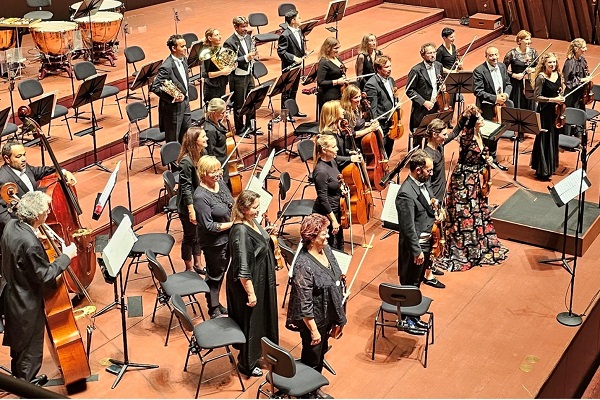 Conductor Chloé van Soeterstède and soloist Alena Baeva front the Luxembourg Chamber Orchestra;
Conductor Chloé van Soeterstède and soloist Alena Baeva front the Luxembourg Chamber Orchestra;
When the Chamber Orchestra of Luxembourg (OCL) with the support of women's group The NETWORK hosted their recent 50th anniversary Indian Summer concert at the Philharmonie, how many attendees would have reflected on the significance of one particular aspect of the performance, namely that the first half of the evening was deliberately dedicated to women?
It featured Swedish composer Katarina Leyman's Roller Coaster: Super 8 for Symphony Orchestra under the baton of internationally renowned French conductor Chloé van Soeterstède and featuring prize winning Luxembourg naturalised violin soloist Alena Baeva.
Casually this may, and should, have not been significant at all, but there is a history behind the participation of women in classical music that tells a different story.
Statistically the classical music "scene" remains a male dominated environment, whether it be the musicians in the orchestra, the conductors or the composers. Although women had long been encouraged to learn to play classical instruments, that encouragement did not extend to performing in public, and most certainly not to actually writing any music for a wider audience. During the second half of the nineteenth century, that attitude gradually started to relax, and the first "female only" orchestras started to appear. It wasn't until 1913 that the first women were allowed to play in a "major orchestra" when Sir Henry Wood hired six female violinists to play in the Queen's Hall Orchestra in London. In the USA, it was not to be until 1930 that the first woman played in a top orchestra when Edna Phillips was accepted into the Philadelphia Orchestra as a harpist. As for the famously traditional Vienna Philharmonic, they finally accepted the inevitable and allowed women to become full members in 1997 when another harpist, Anna Lelkes, became their first official female representative.
The glacial nature of this progression was evinced in studies in 1995 by Allmendinger and Hackman and again in Suby Raman's 2014 study Graphing Gender in America’s Top Orchestras which showed that overall barely a third of the seats in the orchestra pit were occupied by women. Similarly, when it comes to conductors, a 2016 study of 174 American ensembles found that over 90% were directed by males.
Within the broader context of gender representation in the arts, the group CID | Fraen en Gender, with the financial support of the Municipality of Differdange, engaged the Luxembourg Institute of Socio-Economic Research (LISER) to study specifically the 2022/2023 arts programme across Luxembourg, and came to similar conclusions regarding classical music. They found that overall over 80% of all participants in the domain were male, and that for the professions of conductor/musical director that figure rose to 87% and for featured composers no fewer than 92.3% were male. Only in the case of soloists did female representation even break the 20% barrier, with a still under-representative 29.3% of the total.
Following her participation in a round table on cultural programming and gender representation in classical music in Luxembourg organised by Radio 100,7, Mariana Florea, President of The NETWORK, took the opportunity to join forces with the Chamber Orchestra of Luxembourg in raising the profile of women in classical music. Thus, well over 100 of the attendees at the Indian Summer event were associated with The NETWORK.
While individual initiatives like this are important in their own right, it is nonetheless only at institutional level that such inequalities can be addressed. The European Union Presidency Conclusions on Gender Equality in the Field of Culture in 2020 went some way towards establishing the EU position, and the OMC expert group report Towards Gender Equality in the Cultural and Creative Sectors suggested a set of policy recommendations, but there is clearly much work that still needs to be done to move from gender equality in the arts being an agenda item on numerous wishlists to concrete action that will ultimately mean that one day it really will no longer be significant that a woman is conducting a woman soloist in an orchestral piece composed by a woman.









